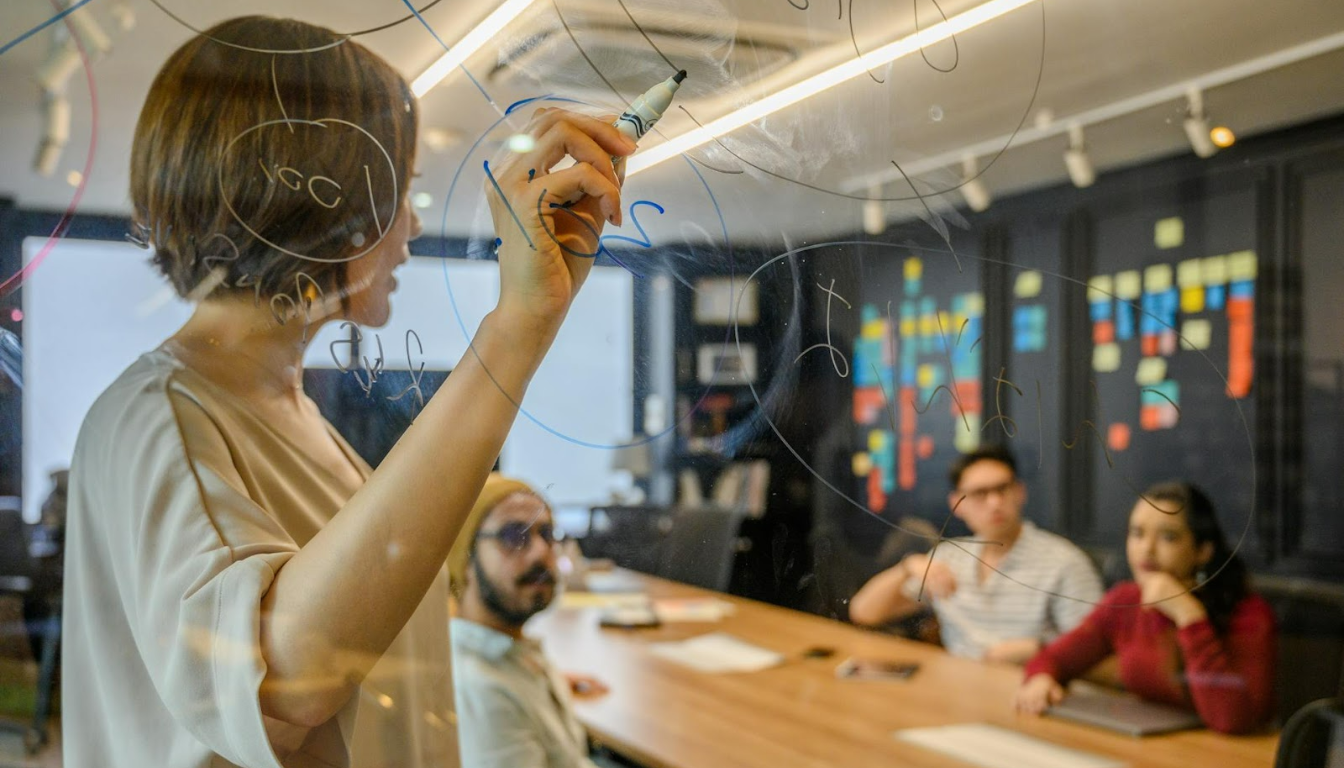Top Strategies for Improving Team Dynamics

Struggling with team collaboration and productivity? Improving team dynamics is the answer. This article covers actionable strategies to boost communication, trust, and teamwork, ensuring your team works efficiently and harmoniously.
Key Takeaways
- Positive team dynamics enhance engagement, trust, and productivity, leading to smoother workflows and reduced misunderstandings.
- Key elements for fostering positive team dynamics include open communication, clearly defined roles and responsibilities, and shared goals.
- Strong leadership is vital for establishing healthy team dynamics, as effective leaders model collaborative behaviors and foster psychological safety.
Understanding the Importance of Team Dynamics

Team dynamics are the cornerstone of a productive and engaged workforce. When team dynamics are positive, they enhance engagement, trust, cooperation, and productivity, which are essential for reaching shared goals. In environments with healthy team dynamics, employees feel respected and valued, fostering a sense of belonging and mutual accountability. This alignment among team members leads to smoother workflows and reduces ambiguity and confusion, allowing the team to focus on their tasks rather than getting bogged down by misunderstandings. Good team dynamics are crucial for achieving these outcomes.
Recognizing the importance of team dynamics also means being vigilant about the signs of poor dynamics. Dysfunctional team dynamics can lead to low morale and reduced productivity among team members. Early identification of these indicators allows teams to address issues proactively, ensuring long-term success and cohesion.
Definition of team dynamics
Team dynamics refer to the ways in which a team operates and interacts. This encompasses:
- Communication styles
- Decision-making processes
- Conflict resolution
- Roles
- Responsibilities
- Team cohesion
- Team’s dynamics
Grasping team dynamics is crucial for overall team effectiveness. The interplay among team members and other team members—how they communicate, build relationships, and establish trust—determines how effectively the whole team functions.
Diverse personality types, strengths, weaknesses, and expertise are essential for effective team dynamics. Regular discussions around team dynamics, such as during retreats and training, can enhance the overall effectiveness of the team. When team dynamics are positive, they often stem from fostering a sense of belonging, mutual support, psychological safety among team members, good group dynamics, and diverse perspectives.
Distinguishing team dynamics from group dynamics
While team dynamics involve coordinated, goal-oriented behavior towards a common outcome, group dynamics do not necessarily share this characteristic. In teams, performance evaluation is collective, whereas individual assessment is more typical in groups. Understanding these differences is crucial for effective team management, as it helps in tailoring approaches that are specific to the needs of a team rather than a group.
For instance, group dynamics might focus more on how individuals interact within a social setting, whereas team dynamics are concerned with how these interactions influence group dynamics and the team’s ability to achieve its goals. By distinguishing between the two, team leaders can better implement strategies that enhance team cohesion and productivity.
Key Elements for Positive Team Dynamics

Positive team dynamics are built on several key elements: clarity, communication, and commitment. These elements are crucial for creating a supportive work environment where team members trust each other and work collaboratively towards common goals. When these key factors are in place, they promote cohesion and effectiveness, boosting productivity by as much as 50%, leading to a productive team. Additionally, understanding team composition can further enhance these dynamics.
Practices such as intentional check-ins and alignment on shared goals are adopted by the most consistent great teams. Considering these key factors can enhance team dynamics and improve performance in well functioning teams.
The following subsections will delve deeper into each of these key components: open communication, clearly defined roles and responsibilities, and shared goals and vision.
Open communication
Open communication is the lifeblood of any team. It reduces conflicts, fosters trust, and encourages innovation among team members. A lack of effective communication can exacerbate misunderstandings and conflict within the team. Clear communication ensures that everyone can communicate effectively, avoiding miscommunication and keeping the team aligned with its goals.
Practices such as active listening and giving meaningful feedback are crucial for fostering open communication in teams. When team members feel heard and respected, they are more likely to share new ideas and collaborate effectively through collaborative problem solving. Encouraging open discussion and creating an environment of mutual respect can significantly enhance team dynamics.
Clearly defined roles and responsibilities
Clearly defined roles are crucial as they provide clarity and coordinated effort towards common goals. Recognizing different roles within a team helps teams operate more effectively, as it reduces conflicts and improves efficiency. When roles and responsibilities are clearly defined, it helps clarify roles, evenly distributing workloads and reducing duplicate efforts.
Key factors that contribute to a strong and cohesive team include:
- Establishing clear communication channels to enhance team cohesion
- Complementary strengths and weaknesses among team members
- Well-defined roles within the team
- Periodically reviewing team goals and roles to align work with objectives and promote cooperation
Shared goals and vision
Shared, common goals are essential for team dynamics. They keep teams aligned during shifts in priorities and challenges, increasing support for one another and enhancing decision-making. Having a shared mission unifies team members and directs their efforts towards common objectives.
When team members are united by the same value vision, a team member is more likely to collaborate effectively and contribute to the team’s success. This unity fosters a sense of purpose and belonging, which are crucial for maintaining healthy team dynamics and achieving high performance. When a team works together, the potential for success increases significantly.
Strategies to Improve Team Dynamics

Improving team dynamics involves implementing various strategies to boost cooperation, communication, and engagement. These strategies aim to strengthen connections, improve communication, and support long-term collaboration among team members. Changes in team dynamics can be prompted by creating tension, role shifts, or new members joining.
Offering coaching in team dynamics can unlock employees’ full potential and help them navigate challenges. Customizing teamwork interventions to fit the specific group and individual team members enhances their effectiveness, allowing teams to co create solutions. Understanding organizational behavior is essential in this process.
Offsite retreats are designed to enhance teamwork by providing a break from daily routines, sparking innovation, and strengthening company culture.
Implementing regular feedback mechanisms
Key points about regular feedback include:
- It helps identify problems early and allows for quick course corrections.
- Consistency in the feedback process is key for feedback to be useful.
- Surveys and collaborative platforms can help team members who are uncomfortable speaking up.
- Creating a culture of regular feedback encourages open dialogue and helps in identifying areas for improvement.
Promoting open communication and using collaborative efforts encourages constructive feedback. Regular feedback sharing fosters continuous improvement and mutual respect, enhancing overall team dynamics.
Encouraging team building activities
Team building activities can significantly enhance trust, communication, and collaboration within a team. Participating in these activities boosts employee morale. This positive effect is beneficial for the overall work environment. Effective team-building activities include sharing experiences, problem-solving tasks, and project retrospectives. Dividing the group into smaller teams for activities like scavenger hunts focuses on collaboration and problem-solving. Incorporating team building exercises can further strengthen these outcomes.
Determining specific objectives before implementing team-building activities ensures alignment with the team’s goals. Regular team-building activities are very effective at shifting group dynamics, leading to improved teamwork over time.
Remote teams can enhance team building by utilizing asynchronous prompts within communication channels for new teams.
Promoting psychological safety
Psychological safety enables team members to take risks and share ideas without fear of negative repercussions. Software tools can help establish psychological safety by promoting open communication and connections among team members. When team members feel safe to speak up, it fosters an environment of trust and innovation, which are crucial for healthy team dynamics.
Encouraging open discussion and creating a supportive environment where employees feel connected can significantly improve team dynamics. When team members trust each other and feel safe to express their thoughts, it leads to a more productive and cohesive team culture.
The Role of Leadership in Enhancing Team Dynamics

Strong leadership is essential for establishing a healthy team dynamic, which can lead to heightened productivity and engagement. Leaders are crucial in shaping supportive work environments by setting the tone for interaction and collaboration. Weak leadership can adversely affect team dynamics, causing confusion and dysfunction among team members.
Managers influence team dynamics by setting expectations, creating norms, and modeling responses to challenges. Establishing psychological safety is foundational for teams to feel secure and express themselves freely.
The impact of Satya Nadella’s leadership at Microsoft illustrates how effective leaders can reignite innovation and create top workplaces with innovative ideas, as discussed in the Harvard Business Review.
Characteristics of effective team leaders
Trust influences team dynamics; it plays an essential role in how team members interact and collaborate. Psychological safety allows team members to express themselves fully, enhancing creativity and collaboration. Creating an environment of belonging through inclusive leadership fosters trust and psychological safety within the team.
Effective leaders nurture a collaborative environment by encouraging open dialogue and valuing team contributions. Key traits of effective leaders include empathy, clear communication, and the ability to admit when they don’t have all the answers.
The combination of trust, psychological safety, and effective leadership traits contributes significantly to positive team dynamics.
How leaders can model positive behavior
Leaders can model positive behavior by demonstrating collaboration, empathy, and open communication. For example, Satya Nadella influenced team dynamics at Microsoft by hosting listening tours and redefining leadership style KPIs to focus on mentorship. Democratic leaders champion feedback and value insights, which encourages team participation.
To promote psychological safety, leaders should actively invite feedback and foster open dialogue among team members. By modeling these behaviors, leaders can create a supportive and inclusive environment that enhances team dynamics.
Recognizing and Addressing Poor Team Dynamics
Poor team dynamics can lead to reduced collaboration. This often results in diminished innovation and increased turnover as well. A toxic organizational culture leads to conflicts, frustration, disengagement, and turnover among teams. It is crucial to recognize signs of dysfunctional team dynamics and address bad team dynamics to nurture positive dynamics.
Identifying poor team dynamics early gives teams a better chance to rectify the course before significant problems arise. Clear identification of healthy versus unhealthy behaviors is crucial for effective team dynamics.
Signs of dysfunctional team dynamics
Common indicators of poor team dynamics include issues like repeated conflicts, lack of trust, and poor communication. Signs of unhealthy team dynamics can manifest as clashing egos, failures in communication, and an overall lack of unity among team members. If poor team dynamics are present, it can lead to significant consequences such as falling short of goals and creating a strained work environment.
Recognizing these indicators early is crucial for maintaining a healthy team environment and preventing burnout, anxiety, and stress among team members.
Steps to improve and rebuild team cohesion
When team members feel disengaged or unmotivated, it often points to unhealthy dynamics at play. Small, intentional shifts in work and communication can significantly improve team cohesion. Teams should focus on implementing these small changes in communication and collaboration to enhance alignment. Handling conflict constructively leads to stronger, more resilient teams and better understanding among team members.
Initiating intentional check-ins and creating opportunities for open dialogue can help rebuild trust and engagement within the team. Providing spaces for team members to express their concerns and suggestions fosters a supportive environment conducive to positive team dynamics. By addressing conflicts constructively, teams can build a more cohesive and productive work environment.
Tools and Techniques for Strengthening Team Dynamics
To strengthen team dynamics, it’s essential to leverage the right tools and techniques. Wonderlic Team Dynamics provides objective data on communication styles, motivators, strengths, and weaknesses of team members. These insights can help managers build well-balanced, high-performing teams. Effective communication and collaboration within teams can be significantly enhanced through the use of data-driven insights.
By utilizing tools that offer science-based insights and tactics for team performance, managers can make informed decisions that lead to better team dynamics. The following subsections explore specific software tools for better communication and conflict resolution techniques.
Using software tools for better communication
Essential tools for workplace communication and collaboration include project management tools, messaging apps, and document-sharing platforms. ActiveCollab supports effective communication and collaboration through its wide range of features. Synchronous communication can be facilitated through built-in chat features and group messaging options.
ActiveCollab also supports asynchronous communication by allowing:
- Comments
- Mentions
- Discussions
These features keep team members informed flexibly. Comments can be converted into tasks, ensuring that important discussions do not get lost. Project management features, such as task organization and real-time collaboration tools, significantly enhance team productivity.
Conflict resolution techniques
Unaddressed conflict is a common cause of derailment in team progress. Handling conflict early is a strategy to maintain team alignment during conflicts. Pixar structures conflict among team members by explicitly separating people from the problem and creating a safe space for disagreement.
Creating neutral ground is a method for structuring difficult conversations. Teams can document conflict navigation norms in a Slack canvas or team wiki. By addressing conflicts constructively and providing a safe space for open dialogue, teams can enhance their dynamics and overall effectiveness.
Offsite's Approach to Improving Team Dynamics

Offsite specializes in improving team dynamics by designing retreats and experiences that strengthen collaboration, trust, and communication. These retreats provide a fresh environment that fosters collaboration and growth among team members. Offsite helps leaders learn how to improve team dynamics, manage workplace group dynamics, and implement strategies for building and optimizing team dynamics.
Offsite’s tailored approach ensures organizations can effectively align, reduce friction, and unlock higher team performance. By utilizing Offsite’s services, companies can enhance their team dynamics and achieve greater success.
Benefits of Offsite's services
Offsite corporate retreats offer a stress-free planning experience, letting companies focus on team engagement without logistical worries. Offsite simplifies planning processes, providing comprehensive support and exclusive offers. Companies can enjoy hassle-free planning, ensuring all details are managed effectively for a smooth retreat experience.
Exclusive Offsite discounts make retreat planning more affordable for organizations. With Offsite’s services, companies can save up to 50% on:
- Room blocks
- Meeting spaces
- Food & Beverage (F&B)
- Other corporate retreat budget items
This cost-effectiveness, combined with comprehensive support, makes Offsite an ideal choice for corporate retreats.
How Offsite creates impactful team experiences
Offsite specializes in creating retreats that enhance team dynamics through thoughtfully designed experiences. Retreats are designed with a flexible agenda to balance structured activities and spontaneous bonding moments, ensuring a memorable experience. Activities such as outdoor adventure courses and culinary challenges promote team bonding and foster trust and collaboration.
These carefully crafted experiences help team members build stronger relationships and improve overall team dynamics. By focusing on activities that enhance communication and trust, Offsite ensures that teams return from retreats more cohesive and effective.
Summary
Understanding and improving team dynamics are crucial for any team’s success. By fostering open communication, clearly defining roles and responsibilities, and aligning team members with shared goals, teams can achieve higher performance and productivity. Implementing regular feedback mechanisms, encouraging team-building activities, and promoting psychological safety are effective strategies to enhance team dynamics. Strong leadership plays a vital role in shaping these dynamics, and recognizing and addressing poor team dynamics early can prevent long-term issues. Utilizing tools and techniques, such as software for better communication and conflict resolution methods, can further strengthen team dynamics. Offsite’s approach to improving team dynamics through tailored retreats provides a holistic solution that enhances collaboration, trust, and communication within teams. By investing in positive team dynamics, organizations can unlock their full potential and achieve greater success.
FAQs
- What are team dynamics?
Team dynamics are essential as they encompass the interactions, communication styles, and roles within a team, impacting how effectively team members collaborate and resolve conflicts. Understanding these dynamics is key to enhancing team performance and cohesion.
- How can leaders improve team dynamics?
Leaders can enhance team dynamics by fostering open communication and defining clear roles, which helps create a collaborative environment. This approach aligns team members around shared goals while ensuring psychological safety.
- What are some signs of dysfunctional team dynamics?
Dysfunctional team dynamics are evident through repeated conflicts, lack of trust, poor communication, clashing egos, and a noticeable absence of unity among team members. Addressing these issues promptly is crucial for fostering a healthy team environment.
- How can team-building activities improve team dynamics?
Engaging in team-building activities fosters trust, communication, and collaboration, ultimately enhancing team dynamics and creating a more cohesive work environment. By strengthening interpersonal relationships, these activities contribute to improved morale among team members.
You may also like
Unique spaces for your next offsite
Find distinctive venues for your upcoming corporate retreat.
Stay Updated with Our Insights
Get exclusive content and valuable updates directly to you.







